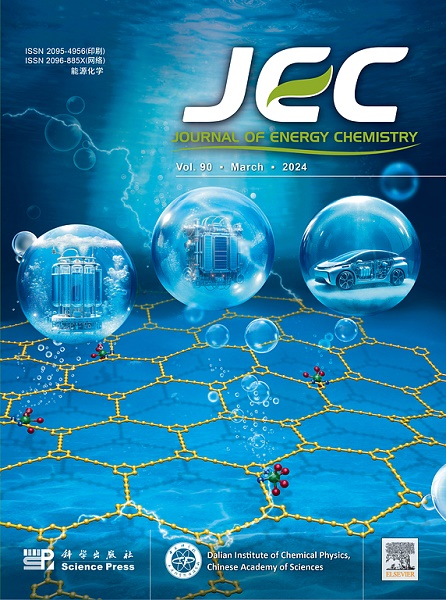In situ construction of Co-CoO heterostructures on rGO-modified nickel foam for high-performance anode catalysts in direct borohydride-hydrogen peroxide fuel cells
IF 13.1
1区 化学
Q1 Energy
引用次数: 0
Abstract
Direct borohydride hydrogen peroxide fuel cells (DBHPFCs) are emerging as a transformative technology for sustainable energy conversion. Despite their potential, their efficiency is largely hindered by the limitations of the anode catalyst. In response to this challenge, we have developed a novel series of Co-based heterojunction metal–organic framework (MOF) derivatives, supported on reduced graphene oxide (rGO)-modified nickel foam (NF), to enhance borohydride electrooxidation performance. Our synthesis involves the thermal transformation of a ZIF67-Co(OH)2-rGO/NF precursor within a controlled temperature between 300 and 750 °C, yielding distinct phase heterostructures and pristine Co and CoO, verified by X-ray diffraction (XRD) and transmission electron microscopy (TEM) analyses. Additionally, the Ultraviolet photoelectron spectroscopy and theoretical calculation result further validate the formation of the heterojunction and direction of electron transfer along the interface as well as the BH4− adsorption behavior across the heterointerface. Notably, the catalyst annealed at 600 °C, designated Co-CoO@C-rGO/NF-600, exhibits an exceptional oxidation current density of 2.5 A·cm−2 at 0 V vs. Ag/AgCl in an electrolyte containing 2 mol·L−1 NaOH and 0.4 mol·L−1 NaBH4 Furthermore, the Co-CoO@C-rGO/NF-600 catalyst demonstrates remarkable performance as the anode catalyst in a DBHPFC assembly, achieving a peak power density of 385.73 mW·cm−2 and demonstrating the enduring operational stability. The superior electrocatalytic performance is primarily attributed to the synergistic effects of Co-CoO nanoparticles rich in active heterointerfaces and the superior electron mobility afforded by the rGO scaffold. These results not only deepen our understanding of anode catalyst design for DBHPFCs but also pave the way for breakthroughs in electrocatalytic technologies, driving forward the quest for sustainable energy solutions.

氧化石墨烯修饰泡沫镍上Co-CoO异质结构的原位构建,用于直接硼氢化物-过氧化氢燃料电池的高性能阳极催化剂
直接硼氢化物过氧化氢燃料电池(dbhpfc)正在成为一种可持续能源转换的变革性技术。尽管它们具有潜力,但它们的效率在很大程度上受到阳极催化剂的限制。为了应对这一挑战,我们开发了一系列新的co基异质结金属有机框架(MOF)衍生物,以还原氧化石墨烯(rGO)-改性泡沫镍(NF)为载体,以提高硼氢化物的电氧化性能。我们的合成涉及到ZIF67-Co(OH)2-rGO/NF前体在300到750℃的控制温度下的热转变,得到不同的相异质结构和原始的Co和CoO,通过x射线衍射(XRD)和透射电子显微镜(TEM)分析证实。此外,紫外光电子能谱和理论计算结果进一步验证了异质结的形成、电子沿界面的转移方向以及BH4 -在异质界面上的吸附行为。值得注意的是,在600°C下退火的Co-CoO@C-rGO/NF-600催化剂在含有2 mol·L−1 NaOH和0.4 mol·L−1 NaBH4的电解液中,在0 V下对Ag/AgCl的氧化电流密度为2.5 A·cm−2。此外,Co-CoO@C-rGO/NF-600催化剂在DBHPFC组件中作为阳极催化剂表现出出色的性能,峰值功率密度达到385.73 mW·cm−2,并表现出持久的运行稳定性。优异的电催化性能主要归功于富含活性异质界面的Co-CoO纳米颗粒的协同作用和氧化石墨烯支架提供的优异的电子迁移率。这些结果不仅加深了我们对dbhpfc阳极催化剂设计的理解,而且为电催化技术的突破铺平了道路,推动了对可持续能源解决方案的追求。
本文章由计算机程序翻译,如有差异,请以英文原文为准。
求助全文
约1分钟内获得全文
求助全文
来源期刊

Journal of Energy Chemistry
CHEMISTRY, APPLIED-CHEMISTRY, PHYSICAL
CiteScore
19.10
自引率
8.40%
发文量
3631
审稿时长
15 days
期刊介绍:
The Journal of Energy Chemistry, the official publication of Science Press and the Dalian Institute of Chemical Physics, Chinese Academy of Sciences, serves as a platform for reporting creative research and innovative applications in energy chemistry. It mainly reports on creative researches and innovative applications of chemical conversions of fossil energy, carbon dioxide, electrochemical energy and hydrogen energy, as well as the conversions of biomass and solar energy related with chemical issues to promote academic exchanges in the field of energy chemistry and to accelerate the exploration, research and development of energy science and technologies.
This journal focuses on original research papers covering various topics within energy chemistry worldwide, including:
Optimized utilization of fossil energy
Hydrogen energy
Conversion and storage of electrochemical energy
Capture, storage, and chemical conversion of carbon dioxide
Materials and nanotechnologies for energy conversion and storage
Chemistry in biomass conversion
Chemistry in the utilization of solar energy
 求助内容:
求助内容: 应助结果提醒方式:
应助结果提醒方式:


